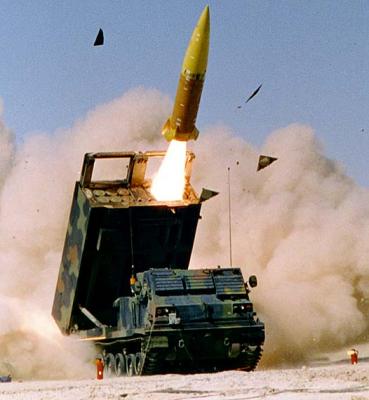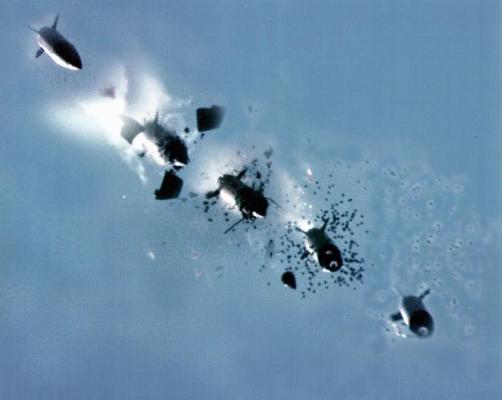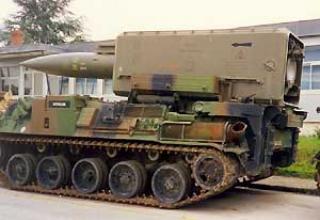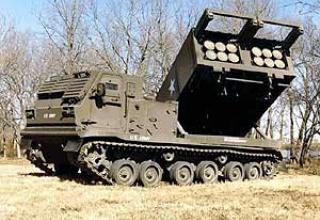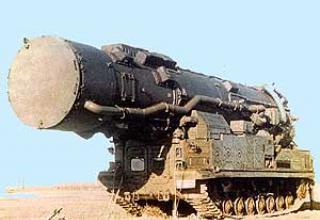Operational-tactical missile system "ATACMS" (Army Tactical Missile System) is designed to engage point targets such as command posts, missile launchers, air defense facilities, communication centers, warehouses of fuel and lubricants, located in the depth of enemy defense in any weather conditions, at any time of day. To launch the missile uses an upgraded M270 launcher MLRS (Multiple Launch Rocket System).
In early 1976, the U.S. Army Missile Command adopted the concept of the General Support Rocket System (GSRS), which uses cheap ammunition and has a high rate of fire. This system was intended to be used to defeat enemy manpower and lightly armored targets, to disable communications, air defense systems and command centers. Therefore, 1976 can be considered the year of birth of the main and only basic U.S. Army APC - ATACMS.
In March 1976, five companies - Boeing Aerospace, Emerson Electric, Martin Marietta, Northrop and Loral Vought Corporation - were asked to formulate and formalize the GSRS concept. After reviewing all five projects in September 1977, two companies, Boeing Aerospace and Loral Vought Corporation, were selected. They were awarded contracts for 29 months. Under these contracts, the companies undertook to supply three prototype systems and ammunition each for testing at the White-Sands (New-Mexico) missile range.
In early 1978, the Missile Arms Development and Research Council reoriented the GSRS program to use standard NATO ammunition, which could be produced both in the United States and Western Europe. At the same time, the program was renamed MLRS.
In 1980, Loral Vought Systems was chosen as the main company in the development of the prototype and the following companies were involved in the work with it:
- "Atlantic Research Corporation - development of solid rocket engines.
- "Bendix Guidance System Division - development of guidance and positioning systems.
- "Brunwick Corporation - development of launch containers.
- "Norden Systems - development of fire control systems.
- "Vickers" - motion control systems.
In March 1990, after the completion of tests at the White-Sands range, the ATACMS system was adopted by the U.S. Army (see chronology of creation and modernization of the complex).
Composition:
Artillery unit of the upgraded M270 launcher, mounted on the tracked base of the American infantry fighting vehicle, includes:
- Fixed base mounted on the chassis housing
- Swinging platform with a swinging part mounted on it, which has an armored box farm with two TPKs.
- Charging and pointing mechanisms.
The M270 starter unit (see photo) does not have conventional permanent guides. For charging its armoured boxed farm (the swinging part of the PU) is placed in the sockets of two equipped transport and launching containers (weight TPK-422 kg, dimensions 4166x1051x837 mm) of single use (each with 6 NUR or 1 OTP ATACMS). They are a package of six fiberglass tubular guides mounted in two rows in a box farm made of aluminum alloy. The tubes are factory-fitted and sealed to ensure that the missiles will remain unattended for ten years. Pre-start preparation of missiles for firing is practically not required.
The starting unit is recharged by means of two autonomous charging mechanisms (with electromechanical drives) mounted on the PU in the box farm above the sockets for the TPC. The operation is performed by one or two calculation numbers using a remote control. At zero elevation angle the charging mechanism with the help of the winch raises the TPC from the ground up to the stop and moves it into the socket of the box farm.
Operational-tactical missile ATACMS performs its flight along the so-called semi-ballistic trajectory, when its initial acceleration is carried out on a pre-programmed rigid trajectory, and all subsequent flight after reaching its apogee is in a controlled mode. The missile is controlled by aerodynamic rudders using signals from the onboard control system, which continuously determines the intended point of impact and generates appropriate commands to align it with the target. In this regard, at short and medium ranges, the flight path of the OTR has a pronounced "second apogee". In addition, in the interest of hiding the coordinates of the starting position, it can be launched at an angle to the firing plane at ranges less than the maximum.
ATACMS is currently available in several versions, which differ primarily in terms of type of combat unit, control system and range of fire.
The MGM-140A (see layout diagram) missile has an M39 cassette warhead equipped with M74 submunitions designed to engage the enemy's manpower and easily defensible material part. Each missile is equipped with approximately 950 M74 submunitions and has a firing range of up to 165 km. The main purpose of the cluster warhead is delivery to a given area and payload distribution. The warhead consists of aluminum shells with power elements, front and rear bulkheads. In the center is a cylindrical channel, inside which is located cable route. The warhead contains a blast system that ensures the destruction of the shells and the dilution of submunitions at the required time.
The M74 submunition pod is a steel sheath filled with an explosive substance. In collision with a target and explosion, each submunition amphibious vehicle provides a large number of steel fragments that effectively engage truck-type targets, armoured vehicles and radar antennas. The projectile has a live force radius of 15 m. This ammunition is not effective against armoured vehicles.
The MGM-140 block 1 missile was tested in 1990. The tests yielded unsatisfactory results in terms of hit accuracy, but overall the system was assessed as sufficiently effective. The MGM-140 block 1 was deployed and used in Operation Desert Storm.
2. Block IA (MGM 140B)
The MGM-140B missile (see layout diagram) is an operational-tactical missile with an extended range of up to 300 km. The increased range is achieved by reducing the payload - instead of 950 M74 submunitions the MGM-140B missile carries 275-300 M74. To improve accuracy, the inertial control system was complemented by the NAVSTAR satellite navigation subsystem. Circular probable deviation for this model is not more than 25m. If the satellite navigation subsystem does not operate for any reason, block 1A is controlled only by the inertial control system. It is possible to install additional thermal protection on the nose fairing of the MGM-140B missile. An upgraded M270 or M270A1 launcher is used to launch the missile. Modernized M270 PU is equipped with satellite positioning equipment, M270A1 PU, in addition, it has an improved fire control system, reinforced mechanical part and a loading and unloading device.
ATACMS block 1A was tested in August and September 1996. During the tests, a number of deficiencies in the missile control system were identified. On June 25 and December 3, 1997 the modified missile successfully passed flight tests. In April 1996 the program of production and acquisition of 70 ATASMS block 1A missiles was signed.
A drawing of block 1A glider was provided to establish the necessary dimensions.
On the basis of Block IA developed a version of the OTR, designated Block IA Unitary, with a range up to 300 km and a new unitary combat unit weighing 227 kg.
The MGM 164A missile (see layout chart) is a tactical operational missile with a range of up to 140 km, designed to engage moving armored targets, as well as to defeat well-protected enemy firing positions and important supply points. To accomplish such tasks, this modification is equipped with a self-guided BAT warhead (see description).
At the moment, the BAT combat unit has been upgraded to the P3I BAT. It is an upgraded version of the BAT, which retains all basic physical characteristics and dimensions. Changes have mainly affected the set of targets to be hit. It is now possible to hit armored targets, both mobile and static, multi-temperature targets. Also, the electronic filling of BAT has undergone changes. Sensors became less sensitive to difficult weather conditions and means of electronic warfare.
Defeat of the target occurs in the following sequence:
- There is a special air bag inside the compartment with fighting elements. As the missile passes through the apogee, pressure is applied to the air bag and the BAT is separated. Separation can take place at subsonic and supersonic speeds.
- BAT stabilizes its movement by twisting around an axis of symmetry, then reducing the speed with its means.
- After all preliminary mechanical operations, the software comes into play. Target breeding takes place. Each of the BATs operates in its own predefined sector, which is divided into the entire area of the target.
- After disassembling the targets are pursued and defeated with the help of modern tandem cumulative combat unit.
There is information that some BATs were equipped with GP transmitters and video equipment to receive information from the battlefield.
4. Block IIA (MGM 164B) - Armored personnel carrier is a modification of Block II with increased range, which was achieved due to the reduced weight of the combat unit. It carries instead of 13 BAT - 6 upgraded P3I BAT.
A further development of the MGM 164 is the development of the All-In-One-Dispenser, a forward-looking, modular, flexible system designed to integrate the entire range of high-precision warheads into Block II. In the course of modern combat operations with a rapid change in combat mission, it is now possible to quickly change the missile's combat equipment in the field using different ammunition. As can be seen from the drawing, the system looks like a drum with the combat elements placed on a circle.
5. Block III - a promising operational-tactical missile with a new combat unit with penetration capability. The proposed design consists of the Mk4 nuclear warhead hull (used to equip the Trident-1 and Trident-2 SLBMs), inside of which there is a penetrating type warhead equipped with conventional explosives and a flight control system at the final point of the trajectory. Such missiles are designed to engage well-protected objects (underground control points, hangars, etc.) and have a firing accuracy of about 10 m.
In addition, work is underway on a new solid propellant rocket engine, which allows to increase the range up to 500 km, which is the limit under the DSMD treaty of 1989.
Tests conducted in 1994, confirmed the fundamental feasibility of a mobile lightweight version of the ATACMS, which received the designation HIMARS (Hight Mobility Artillery Rocket System). HIMARS for the ATACMS missile is a single missile launch container on an off-road wheeled chassis, which is also a launcher. The total weight of the system is about 13000 kg, which will make it possible to use C-130 aircraft for its transportation to the war zone. Thanks to modern equipment, the time to move to the combat position after unloading from the aircraft is 10 minutes.
In parallel with the above work, the U.S. Navy Department led the research and development of the ship's version of the missile system, designated NTACMS, which was intended to be used to fire support maritime landing operations. At present, this work has been suspended, but the appearance of new modifications of the ATACMS missile, which have extensive combat capabilities, according to U.S. experts, will facilitate their resumption. The NTACMS system will use modified vertical Mk41 launchers, which are equipped with Ticonderoga-type cruisers and Eagle Burke-type destroyers. The technical feasibility of the project was confirmed at the end of 1996 during the experiments conducted at White Sands Test Site. At the same time, the United States Naval Forces Command is considering the option of placing such missiles on board multipurpose submarines and Ohio SSBNs in the event that they are removed from Trident-1 missiles.
Characteristics:
| Parameter name | ATACMS block I, (MGM 140A) |
ATACMS block IA, (MGM 140B) |
ATACMS block II, (MGM 164A) |
ATACMS block IIA, (MGM 164B) |
| Combat equipment | M-74 Anti-Personnel Anti-Material (APAM) Battle shrapnel elements 950 pcs., 560 kg |
M-74 Anti-Personnel Anti-Material (APAM) Battle shrapnel elements 300 pieces, 160 kg. |
Brilliant Anti-armor submunitions (P31 BAT). Self-directed combat unit 13 pcs., 450 kg. |
Brilliant Anti-armor submunitions (P31 BAT). Self-directed combat unit 6 pcs., 268 kg. |
| Control System | Inertial guidance system | Inertial guidance system with ring laser gyroscopes + support for satellite trajectory correction with the help of GPS transmitter. | ||
| Type of motor unit | Solid fuel | Solid fuel | Solid fuel | Solid fuel |
| Total weight, kg | 1670 | 1320 | 1480 | 1463 |
| Length, m | 3.98 | 3.98 | 3.98 | 3.98 |
| Caliber, m | 0.61 | 0.61 | 0.61 | 0.61 |
| Range of fire, km | 165 | 300 | 140 | 300 |
| Wingspan, m | 0.82 | 0.82 | 0.82 | 0.82 |
| Circular Probable Deviation (CVO),m | 300 | No more than 25. | - | - |
| Deployment time, mines | 5 | |||
| The number of missiles on a standard combat vehicle. | 2 | |||
Testing:
The main elements of the ATACMS system were tested mainly at the White-Sands test site. The system received its baptism of fire in the desert storm. The ATACMS was used to destroy Iraqi army air defense batteries and communications hubs. During the operation, about 200 trucks and equipment were destroyed. The combat effectiveness of these systems has been quite high.
Sources:
- сухопутные войска_ЗВО_3/2000, полковник В. Пауков,"Работы по совершенствованию системы ATACMS".
- Hajime Ozu, "Missile 2000 - Reference Guide to World Missile Systems", Shinkigensha, 2000.a
